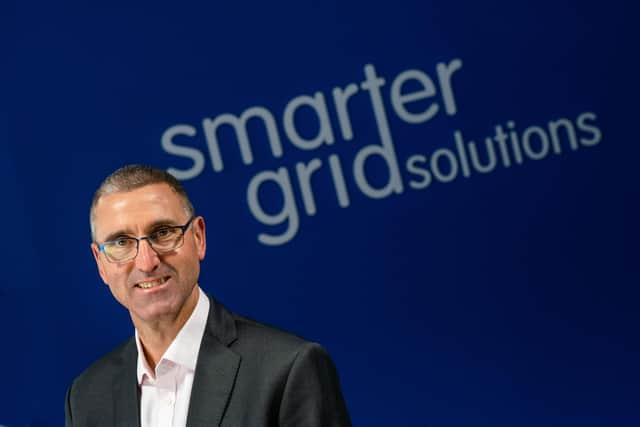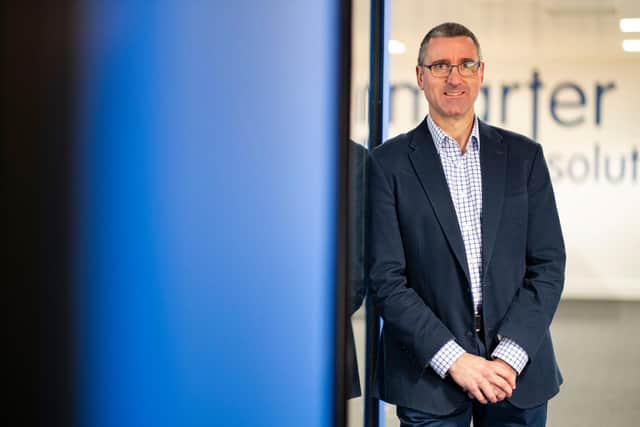The Big Interview: Graham Ault, co-founder and executive vice-president at Smarter Grid Solutions
The executive, formerly professor of power systems at the University of Strathclyde, from which SGS was spun out, has more than 25 years’ experience in the energy sector, including power station design and construction as well as the Glasgow-based firm’s distributed energy management software.
His CV includes spells in Malaysia and Morocco, and he is credited with having led many pioneering initiatives in the smart, flexible, clean energy domain including assignments for UK, US and international utility companies, energy majors, governments, national labs, research agencies, working groups and the investment community.
Advertisement
Hide AdAdvertisement
Hide AdSGS, which also has bases in New York, Texas and California, says its software enables several different sources of energy generation and storage to be handled flexibly, smoothing the peaks and troughs of demand and supply, something that is increasingly important as more renewables go onto national and local power grids.


The firm was snapped up earlier this year by Mitsubishi Electric, and this month announced that it had delivered a “ground-breaking” US grid integration project that it said could more than double wind and solar generation connections.
Can you explain what Smarter Grid Solutions does, aims to achieve, and what your role entails?
It provides the software that manages new, low-carbon energy assets at customer sites, in power networks and in energy markets. Our focus is on the movement towards decentralised forms of energy such as renewable generation – for example, wind and solar power.
Also, electric vehicles, the new generation of electric heating, such as heat pumps that were part of the recent UK government ten-point energy plan. Those new low carbon energy assets need to be monitored and managed so they deliver the greatest amount of financial, energy and carbon-reduction value.


Our software gathers data from all of those energy assets, the power grid, energy markets and other places so that quick decisions can be made and actions taken to keep the whole system secure and deliver the intended benefits of reduced energy bills, reduced carbon, greater on-site usage of renewable energy and lower costs.
I was one of the founders of the company back in 2008 with University of Strathclyde colleagues Bob Currie and Alan Gooding. My role has evolved a lot since then as the company has grown to nearly 100 people today.
My current roles include responsibility for our product strategy and our market and customer engagement, as well as playing my part in our leadership team and working with our new owners.
How did the pandemic affect the firm's operations?
Advertisement
Hide AdAdvertisement
Hide AdAs the evolution of the coronavirus became apparent in February 2020 we quickly made arrangements to enable all of our staff to move to home working.
Until the recent emergence of the Omicron variant we had moved into a hybrid home/office working pattern but we’ve now taken the precautionary measure of home working for all staff. The only exceptions are some of our team who are working on essential projects deemed part of the critical national infrastructure in the UK and US.
At the onset of the pandemic we had to make sure that under various "worst case scenarios” we had a full set of protective measures and contingency plans to minimise the chances of anything deflecting us from supporting our customers in their mission of keeping the energy flowing and the lights on.
We did experience some slowdown in our markets as decisions were affected by uncertainty and the difficulties for physical project delivery but the energy sector has been relatively robust and we have made sure that we are in a strong position to thrive at the other end of this pandemic.
The business is now part of Mitsubishi Electric, and said when the deal was announced that it would help expand SGS’ reach. Can you give more details on how the deal came about and how it will drive your growth?
In SGS we had the benefit of supportive backers at the University of Strathclyde, Scottish Enterprise and venture capital firm Scottish Equity Partners. They worked with our board to explore all the options to identify the right partner to enable us to further develop our products and take advantage of the fast-growing markets for our products.
At the same time as we were doing that work through 2020, Mitsubishi Electric was undertaking a similar process to work out how their US subsidiary could serve its customers best. We both identified the ideal partner in the other organisation, and it then took a few months of intensive work to complete the deal.
Mitsubishi Electric said SGS’ offering aligns with its aim to realise a decarbonized society by 2050 through reduced greenhouse gas emissions. How will SGS help achieve this?
Advertisement
Hide AdAdvertisement
Hide AdUnder Mitsubishi Electric’s wing, SGS can enhance its products significantly so that our customers can bring to life their clean energy aspirations. For example, power grid operators in the US will be able to add much more renewable energy to their grids using our software.
Businesses and communities that suffer from frequent power cuts will be able to build so-called microgrids – mini power grids able to work in isolation when the public network fails – and do that using clean energy technologies.
We’ll be able to take these types of offerings to a much wider set of potential customers because of the scale of Mitsubishi Electric. It already helps power utility companies and energy-users – for example, with their heat pumps – to develop and run a clean grid and now we can help them deliver more value to those customers by making our products work together.
The ultimate test for that theory is whether together we advance cleaner and more sustainable energy and transport systems and building infrastructures.
SGS is present in five countries, and is expanding its customer base, particularly in North America. How is it doing this, and where specifically do you see greatest potential? To what extent will that catalyse overall growth, including headcount?
The greatest need for our software products is in advanced energy systems with strong clean energy goals and supportive regulatory mechanisms. Those provide the basis for our customers to build clean energy assets and integrate them into an energy system where their value is rewarded.
North America, North-western European countries, including the UK, and Australia are the leaders. We are achieving growth in these markets and we now expect that our work with Mitsubishi Electric will increase our footprint with customers in the US.
The business in advance of COP26 called for “big acts from big countries” – while it recently announced that it would almost double the amount of renewable energy that can be generated by customers using its systems in the coming months. How does your offering tie in with net-zero targets?
Advertisement
Hide AdAdvertisement
Hide AdThere are two parts to this true net-zero carbon energy journey. The first is to build and connect up enough clean energy assets to make zero carbon a possibility in rough terms. Our products already help various types of customers do that by addressing various engineering limits but also underpinning financial goals. That big pipeline of renewable energy assets that we are working through with our customers is a good example of this first point.
The second challenge is to optimise the operation of all those assets so we increase the number of hours in a year that an individual customer or the whole system operates at 100 per cent clean energy. That’s actually pretty hard to achieve but we are developing and deploying the tools to help our customers achieve that.
The firm recently flagged how its research and technology have helped create jobs and cut carbon emissions in an energy project trial in Dunbar, East Lothian. What are the implications of this?
That project highlights the many benefits of clean energy and how our technology accelerates and adds value. Working with the grid operator SP Energy Networks, we enabled renewable generation of various types, size and owners to connect to a congested part of the grid.
That got clean energy flowing sooner and the financial benefits heading into the local community. These are some of the reasons that our company is passionate about what we do. We are aiming to replicate that value elsewhere as much as we can.
You moved from academia into corporate life, having cited the “growing gravitational pull” towards the latter – how did you find the adjustment? And what has been the most pivotal moment of your career?
I’ve always been motivated by doing the most interesting things with the best people and being as useful as possible. I’ve been fortunate that that has been possible in my academic work at the University of Strathclyde and in SGS.
There were more similarities between the two than I thought. Subject knowledge, applying that in useful ways, working in highly collaborative teams and trying to lead in a way to encourage all of that are common in both domains.
Advertisement
Hide AdAdvertisement
Hide AdThe most pivotal moment in my career was accepting a PhD opportunity with Professor Sir Jim McDonald, who is now Principal of the University of Strathclyde. That brought me into the incredibly dynamic world of advanced research, new ideas and concepts, an enterprising outlook and a belief that the major challenges could be tackled through such research.
A message from the Editor:
Thank you for reading this article. We're more reliant on your support than ever as the shift in consumer habits brought about by coronavirus impacts our advertisers.
If you haven't already, please consider supporting our trusted, fact-checked journalism by taking out a digital subscription.
Comments
Want to join the conversation? Please or to comment on this article.
